We expose how electricity powers the nervous system. Chris Smith and Hannah Critchlow speak to a panel of experts about why chillis taste hot and mint feels cool, how ion channels could tackle diabetes and the new technique that uses algae could shed light on the brain. In the news, re-programming stem cells in situ, the TV programme that's changing accents 400 miles away, the insects that use natural gears to propel themselves and how you can tell whether a panda is pregnant.
In this episode
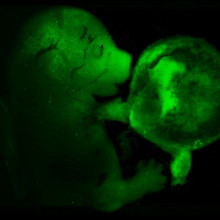
01:14 - Stem cells made in situ
Stem cells made in situ
Mature tissues can be re-programmed in-situ to produce stem cells, scientists have shown for the first time.
The concept of re-programming 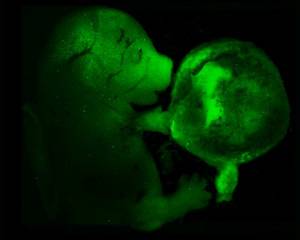 adult cells to switch them from a specialised state to an unspecialised iPS - induced pluripotent - "stem cell" state is well known.
adult cells to switch them from a specialised state to an unspecialised iPS - induced pluripotent - "stem cell" state is well known.
But this manipulation, which involves adding four signalling factors to the cells, has heretofore been carried out in a laboratory dish and with relatively low efficiency.
Now, Manuel Serrano, from the Spanish National Cancer Research Centre in Madrid, and his colleagues have shown that it's also possible to reprogramme cells within mature tissues inside the body without resorting to a Petri dish.
The approach taken by the Spanish team, published this week in Nature, was to first make genetically modified mice into which the genes encoding the four reprogramming chemicals (called c-Myc, Klf4, Oct4 and Sox2) had been inserted under the control of a genetic switch that could be temporarily turned on by administering a dose of an antibiotic drug to the animals.
Administering the drug to the adult mice resulted in growths, in multiple tissues, called teratomas. These are a hallmark of pluripotent cells being formed.
The team were also also to extract from the blood of the animals circulating stem cells resulting from the process; injected into early mouse embryos, these stem cells were able to turn into any tissue in the developing mouse body, proving that they were genuinely unspecialised stem cells.
Interestingly, the cells appeared to be superior in this regard to their counterparts made the traditional way in a dish, suggesting that the three-dimensional nature of the environment in which they formed within organs in some way improves the re-programming efficiency.
Specifically, the cells were capable of giving rise to a broader range of embryonic tissues than traditional iPS cells or even embryonic (ES) stem cells.
These remarkable findings suggest that it may be possible in future to repair organs by triggering the re-programming of a small number of cells locally so they become stem cells that can then be guided, chemically, to reconstruct the tissues damaged by a disease.

07:47 - Quick Fire Science: Giant panda breeding
Quick Fire Science: Giant panda breeding
Here's Dominic Ford and Kate Lamble with this week's Quick Fire Science...
- Giant pandas are native to only a small mountainous region in central China. There are thought to be no more than 3,000 of the animals remaining in the wild, and 300 living in captivity.
- Bamboo makes up 99% of a panda's diet, but its nutritional value is so poor that each animal must eat between 30 and 60 kilograms each day.
- That bamboo also contains so much fibre that panda may need to... empty their bowels... up to 40 times a day.
- To compound the problem, pandas have a digestive system similar to that of other bears, adapted for eating meat rather than a vegetarian diet.
- Their poor diet means that mother pandas have little energy to spare on raising cubs, and their babies are tiny and almost completely helpless at birth.
- Even after a year, panda cubs have typically grown to only a third of their full adult weight.
- In the womb, panda foetuses are unusual in that they do not implant until several weeks into the pregnancy, making it difficult to tell whether a female is pregnant.
- Normally a spike in the hormone progesterone a few weeks before birth tells vets that a female is expecting, but while Tian Tian - the panda in Edinburgh zoo - had such a spike last month, her hormone have since shown contradictory signs.
- Breeding captive pandas is especially difficult as males usually fight over females in the wild, and this seems essential to building up a male's libido.
- Moreover, female panda only ovulate once a year, meaning that there is only a 36-hour window each year in which she can become pregnant.
- Pandas have become endangered because of habitat loss in China due to more intensive farming.
- Even though there are now extensive conservation efforts, their slow rate of breeding means populations grow incredibly slowly.
- Zoo keepers in Edinburgh have said this week that they're uncertain whether a giant panda in the city's zoo might give birth to a cub. But why is it so notoriously difficult to get pandas to breed in captivity, and how can there be so much doubt over whether a panda is pregnant?

10:26 - Can TV programmes change your accent?
Can TV programmes change your accent?
with Jane Stuart-Smith, University of Glasgow
Warning! TV programmes can seriously affect your accent!
At least that's the conclusion of a study published this week by Glasgow researcher Jane Stuart-Smith, who's found that speech characteristics from characters in the popular BBC soap opera Eastenders are being picked up by Glaswegian youngsters...
Jane - We've done some research to look at Glaswegian at the end of the 20th century. And to our surprise, because Glasgow is a very long way away from the southeast - it's about 450 miles away - some of our informants, particularly inner city kids were using features that we would associate more with the southeast of England and much less with Scotland.
Chris - When you say, 'using features', can you just explain what you mean by that?
Jane - Yes. We're looking specifically at features of pronunciation. So, we're looking at, when you say, faffatha and in the following clip, what you'll hear is the word 'tooth' spoken by two people. The older man says, 'tooth' and the younger man says, 'tooth' with a 'fa'.
(Recording)
Jane - It's quite subtle and you might not automatically got it because actually, 'fa' and 'tha' are very easily confusable. In the younger boy, you can hear how he definitely has a Glaswegian 'uh', but he's also got this 'fa' at the end. The other feature that we found which is spreading involves the 'l' sound - things like 'people' and 'shelf'. That is really quite unusual. So here are another two speakers. An older man who's saying 'shelf' and he's got an 'l' sound and the younger adolescent doesn't have it. Can you hear the 'shelf'?
Chris - It's very blatant actually once you highlight it to me. The older person who presumably speaks pure Glaswegian, untainted by whatever we think the influence is, is very different to the younger person who has this new way of saying it.
Jane - Absolutely. They have very different accents. Probably, everybody listening to this programme, if you were to hear those speakers just talking, you would still get the impression that they were both very Scottish and very Glaswegian. So, what's happening is that very specific aspects of that accent are changing, but the rest is staying very similar.
Chris - How did you actually do this research?
Jane - Well, we actually went and recorded people. We worked with some local schools. We thought the people would talk more naturally to each other if they were allowed to choose who they could talk to. They would find a friend and then they would sit and chat to each other, and then we got them to read a word list. And we also got lots of information about their life and their social life. So, we wanted to find out about the kinds of different factors that might affect their speech. So obviously, if you've got somebody saying things like 'shelf' and 'tooth', you might immediately think that it's got to do with the people that they know. Because we know that in language change, what's affects us most is who we talked to on a daily basis. That's how language changes.
Chris - So, you're quizzing them about who your friends are, who you interact with, but also, what you do with your life presumably.
Jane - Exactly, so what we were looking at was everything from, how many family members lived in their house and where their relatives lived and how often they saw their friends, to how often they went out, and the kinds of things they did. And also, amongst all of that, we asked them lots and lots of questions about all aspects of their media: the kinds of music they listened to, radio, films, videos.
Chris - So, what do you think is causing this?
Jane - Well, now we've done the actual study, and we've looked at it statistically, what we found, there are several things together. One of them was to do with social practices. The more that our kids adhered to local Glasgow street style then the more they were going to use its features. We also found a weak relationship with having relatives and friends and family, and communicating with them who are outside Glasgow and specifically in the south of England. And then this other factor was this effect of television. Specifically, we'd looked at a number of programmes, but the programme that emerged as a significant factor in the analysis was EastEnders. It wasn't just watching EastEnders. It's not just having it on. Your mum might be watching it, your auntie might be watching it. It's not that. It's actually really engaging with EastEnders.
Chris - When you say 'engaging', so that would be for example, if I particularly identified with a character or a particular story line had resonance with me and a personal experience. So, I almost identified and wanted to mirror the individual that was having that experience in the programme, that's when what this emulation of the way they speak on EastEnders come through.
Jane - Yes. Well, I certainly agree with you about really being involved in the characters and sort of being involved in the stories. So, I think there's must be at some level, some kind of social identification. But I have to step back a bit about whether this genuinely emulation or imitation of speech because from what we can see, it's definitely not imitation in any sense of being consciously aware, or being able to imitate overtly. We actually looked at imitation as a possible model and the kids couldn't imitate EastEnders characters.
Chris - So, they didn't all go around saying, "Can I have word?" which is what seems to be the buzz word in EastEnders quite frequently.
Jane - Exactly. They're not picking up catch phrases and they're not trying to imitate EastEnders at all, or indeed, they're not really trying to imitate any kind of media. This is one of the reasons that actually, it's taken us a bit of a while to think about, so, what is the mechanism? How is it actually working? Traditionally, linguist have always said the media doesn't have an influence on language change. And there's good reasons for that because when people watch TV, on the whole they get up after their evening viewing and they don't end up speaking with different accents.
Chris - But I will refute the fact to a certain point which is that my children are not very old, but they've been immersed in a lot of cartoons with American voiceovers and I hear them playing the American accents.
Jane - Exactly and we do see a lot of kids using specific voices for specific characters when they're playing, and this is what they do. But I don't think there's any good evidence yet about the features are actually kind of leaking out into their normal pronunciation.
Chris - So, can you put all these together for us into a sort of nutshell. What exactly is the bottom line on what you found?
Jane - Kids in Glasgow with not that much contact with southern English speakers are using more of this London based features and that's significantly associated with strong psychological and emotional engagement with EastEnders.

17:39 - Testicular size a parental predictor?
Testicular size a parental predictor?
Men with smaller testicles tend to be more involved as fathers, a new study suggests. It's not yet known if ball size could be used to pre-emptively predict parenting skills though.
Published this week, in the rather aptly named journal PNAS, James Rilling and  colleagues at Emory University, America, measured the volume of 55 fathers' testicles using MRI scans.
colleagues at Emory University, America, measured the volume of 55 fathers' testicles using MRI scans.
The researchers then compared testicular size with the dads' behaviour, firstly by asking the men questions to find out how involved they are as fathers, such as do you read your child a bedtime story? Do you bath them, or pick them up from school? Would you like to do this if you had the time?
As this could be viewed as a little subjective and reliant on self reporting the researchers also looked at the mothers' thoughts on the fathers' paternal skills, and they looked at the fathers' brain activity, using fMRI to scan the dads' brains as they looked at photos of their children.
The result? Men with smaller testicles got the best parenting scores in the questionnaires AND showed more activity in brain regions associated with empathy and motivation to care. Researchers ruled out the amount of the hormone testosterone as being linked to paternal involvement. More likely, they suggest it's a trade of energy expenditure between mating strategy and parenting. So, maybe men with bigger testes invest more energy in producing higher volumes of sperm, and sperm of higher quality rather than parenting?
Author James Rilling is cautious saying,
"We're assuming that testis size drives how involved the fathers are, but it could be that when men become more involved as caregivers, their testes shrink."
So, although it's possibly tempting to look at a boyfriend's big balls and infer his future parenting skills will be lacking - this may not be the case. Since most fathers choose how involved they are in their child's upbringing. Author Rilling states:
"It might be more challenging for some men to do these kinds of caregiving activities, but that by no means excuses them,"
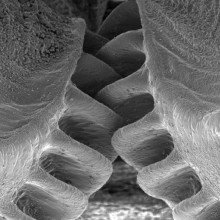
20:43 - Gearing up to jump: insect leg cogs
Gearing up to jump: insect leg cogs
A species of insect that employs gears on its back legs to coordinate its leaping movements has been described by Cambridge scientists...
Using high-speed camera footage running at over 7000 frames per second, zoologist Malcolm Burrows and Gregory Sutton captured the launch movements of the planthopper Issus coleoptratus, a small insect that can take off at over 20 kilometres per hour and can leap over a metre in a single jump.
The insects propel themselves using their powerful hind legs which, the footage revealed, move within 30 millionths of a second of each other.
To achieve this remarkable synchrony, without which the insect would end up hurtling off sidewards, the researchers have found that juvenile planthoppers employ a rack of 12 gear teeth, measuring about a third of a millimetre long in total, that engage between the two legs as the insect primes itself and then executes a jump.
The teeth whizz past each other at the rate of 50,000 teeth-widths per second, and by doing so the rates of acceleration of the two propelling legs are coupled together so they have to move within millionths of a second of each other, keeping the jump on target.
If the gears become damaged they can be replaced when the insect moults as it grows up, the duo speculate. This might also explain why the adult insects jettison this adaptation and resort to some other mechanism to coordinate their leg movements, since with no ability to shed their skin the ability to repair their gearbox would be limited.
Publishing their findings of the first evidence for a natural gearbox in the journal Science, the two researchers emphasise that their results "demonstrate that mechanisms previously thought only to be used in manmade machines have evolved in nature..."

23:08 - The Electrical Nature of Nerves
The Electrical Nature of Nerves
with Dervila Glynn, Cambridge Neuroscience
To celebrate the 50th anniversary of Cambridge researchers Alan Hodgkin and 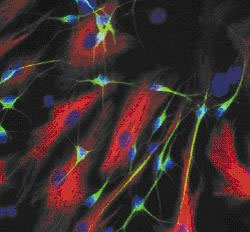 Andrew Huxley, receiving the Nobel Prize for explaining the electrical nature of how nerve cells work, Cambridge is hosting a special neuroscience conference.
Andrew Huxley, receiving the Nobel Prize for explaining the electrical nature of how nerve cells work, Cambridge is hosting a special neuroscience conference.
Top scientists have travelled from around the world for the event, and we've got some of them here with us, as well as Dervila Glynn, the conference organiser.
Hannah - We have Dervila Glynn who is the conference organiser. So Dervila, I believe that Alan Hodgkin and Huxley, they used a particular species in order to understand the electrical properties of the nervous system. They used squid, why?
Dervila - That's correct, Hannah. Simple reason really. What they were studying was the axon or the actual nerve. The simple reason why they used squid was because of its size. So, an axon or the nerve that they were using in squid, it can be measured up to 1mm and they are generally about 0.5mm which is quite big when you consider that a human's is about a thousand times less than that. So, for the practical reasons: they could actually insert electrodes into these axons and measure the electric potential; obviously, they were quite plentiful in the Atlantic; and also, they were able to manipulate the cytoplasm - the salt contents. So, the sodium and potassium, and that's how they were able to measure the voltage in there.
Hannah - So, they got this squid from, I'm presuming not the River Cam...
Dervila - No. Well, in fact actually, they started their experiments in Cambridge in 1935 and in 1939, they released a short paper in Nature, just before the outbreak of war. They both went and then worked in the war. They didn't get back together until 1945. So, they worked in Cambridge, but they also did a lot of their work at the Marine Biological Association Laboratory in Plymouth. That's actually where all the trawlers came in and they got their squid there.
Hannah - And so, they put this wire down the squid's nervous system and then measured that there was electricity that was flowing down this nervous system and that's how they found out that - how a nervous system, in order to control our thoughts and also, in order to allow us to move, uses electricity just like houses.
Chris - What did people think before that then, before we knew that the squid actually were electrically conducting? Do we know what the prevailing wisdom was?
Karl - Well, this is Karl Deisseroth and you've heard my introduction already, but people knew that electricity was involved for a long time before that. People knew that you could stimulate with electrical shocks and get some movement. The genius of the Hodgkin and Huxley was to figure out exactly how the communication happens, what the currency of information flow in neurons actually was. It was this beautiful event called an action potential which is generated by sodium channels and potassium channels that work together in a beautiful pattern. And only by working with the squid could they do this.
Hannah - So, it's the sodium and the potassium, because they're charged ions, because they've got a particular charge on them then they carry a charge and they carry current. That's how they worked out that we can control our thoughts and use thoughts in movement and in the nervous system. So Dervila, you've got this conferences coming up in the next 2 days. What's this conference about?
Dervila - So, this conference really is about 2 things. It's celebrating the award and celebrating Hodgkin and Huxley, but it's also really about their legacy. All of the speakers that we have speaking are doing work that has relations to ion channels, and that's really the big significance of Hodgkin and Huxley's work. So, there'll be people talking about ion channels in respect to all different types of diseases. And so, it's relating the work that they won a Nobel Prize for 50 years ago and how it's actually come forward and how all these important findings - because it's pretty much one of the most important findings in neuroscience. But how it's really translated today. So, there'll be people talking about pain, stroke, multiple sclerosis, Alzheimer's, and also about the basic biology of these ion channels as well.
Hannah - That's brilliant! Thank you, Dervila Glynn from Cambridge Neuroscience.
Frances - Perhaps we should just explain what an ion channel is because the important thing about ion channels are that they conduct ions. They're like ions like sodium and potassium - common salts - to go through them. But they're nothing more than tiny little pores that sit in a membrane that surrounds every one of your cells, not just the nerve and muscle cells, but all cells in the body. The most important thing about them is that they can open and close. When they're open, the ions can go through and when they're closed, they can't. Because the ions flow from a high concentration to a low concentration, they also carry an electric current and that's what is responsible for generating the electrical impulses.
Hannah - So, it's almost like these ion channels are a door that can be opened and closed, that allow charge to go in and out, and that allows electricity to flow.
Frances - I think the important thing to remember is that in living systems, electricity is carried by ions. The currents are carried by ions whereas in the wires that run through your house, they're carried by electrons. So, this is somewhat of a difference.

29:02 - How Do Nerve Cells Signal Pain?
How Do Nerve Cells Signal Pain?
with David Julius, University of California
Some of the speakers from the conference are here with us, including David Julius,
 from the University of California, San Francisco; he studies the part of our nervous system we're probably most consciously aware of, our pain receptors.
from the University of California, San Francisco; he studies the part of our nervous system we're probably most consciously aware of, our pain receptors.
Chris - David, you're very interested in how the nervous system signals pain and looking at your resume, this pot of bright red chillies I have in front of me is something which is featured very much in your work over the years. How does the nervous system signal pain? If I eat one of these, why does it make me feel I've got a pain in my mouth?
David - Well, the nervous system signals pain in the way that Fran has already described that there are ion channels and other molecules that are activated by different stimuli, be it a hot chilli pepper which we'll talk about in a second or temperature or pressure. And that induces the opening and closing of ion channels to change the flow of ions across the membrane when that happens. You activate the cell, excite the nerve fibres, say, a sensory fibre in your lips when you eat a hot chilli pepper. That sends an action potential or message to the brain that you eventually receive as a noxious or painful stimulus. So, the reason that chilli peppers are painful and sometimes people think of this as a taste response, a gustatory response, but it's really a pain response and you would know that if rather than eating the chilli pepper, you chopped one up and then stuck your finger in your eye and there would obviously be a pain response and not a taste response. There's a main pungent ingredient in chilli peppers of the Capsicum family called Capsaicin. The plant has over evolutionary time, developed this compound to fit very nicely into a pocket of an ion channel called the Vanilloid receptor TRPV1 which is pretty highly expressed particularly on nerve fibres that are involved in sensing painful stimuli as it turns out, mostly specified for detecting heat and inflammatory agents. When Capsaicin binds to this channel, it opens up in a way that Fran described. It's like a little doughnut that opens up and ions flow through the membrane and this activates the nerve fibre and then you perceive this is a pain response.
Chris - So, in my nervous system, I've got lots of different sensory nerve fibres which supply my skin and my eyes, and my mouth. Do different nerve fibres detect different sorts of stimuli? So, we're talking about chillies here and if I eat these, I get a stinging painful sensation, but I also would describe it as hot. If I suck on a Polo mint, I get a sensation of coolness in my mouth or if I put my hand in ice, I feel cold. So, are they different nerve cells that are doing those senses?
David - They are to a large extent different nerve cells. So, there was for many years a big debate in the pain area as to whether nerve fibres that detect noxious or pain producing stimuli - of course, these are stimuli that have a capacity to cause tissue damage. That's why we perceive them as being painful. There is a debate as to whether they're all the same functionally or whether there are distinct subsets. And now, we know really through molecular studies that not all pain sensing nerve fibres are the same. They're specifically tuned to detect different things. And so, the subset of nerve fibres that detect cold are to a large extent distinct from those that detect heat. You can tell that because the molecules that are involved in detecting say, Capsaicin from a hot chilli pepper or menthol from mint leaf are the same molecules that are involved in detecting heat versus cold. If you'd look at where those genes are expressed, they're expressed in largely non-overlapping subsets of nerve fibres. So, that's kind of like in what we would say, a labelled line to some extent that you have these different circuits coming in from the periphery that inform you about different sorts of perceptions.
Chris - Just ignoring the effects of chilli for a second, when I'm feeling heat or sensing cold, how are my nerve cells detecting those stimuli? What's going on in the nerve cell to enable it to tell what the temperature is?
David - Well, pretty much the same ways that we just described through these chemical mimics, if you want to say that. For these compounds, these chemicals that illicit these sensations. They're acting on some of the same molecules that are involved, that are actually activated by heat versus cold. And so, they do the same things. They're activating an ion channel that allows ions to flow into the cell. So, when you touch a stove or if you eat a chilli pepper, or put a mint in your mouth, it's basically the same thing. Really, what these compounds from these different plants do is to act on the same ion channels that are involved in sensing heat or cold. What they're really doing is just, they're acting as what we would call allosteric modulators of the channel which basically means that when you eat a mint and when menthol from a mint comes in contact with these channels, they change the temperature at which the channel now must respond to be active.
Chris - So, it sort of fools the channel into thinking it's cooler than it is so it discharges.
David - Enables it to be activated at a higher temperature than it normally would be activated at and that might be for example the temperature of the nerve fibre in your mouth. And so now, the nerve fibre thinks that it just interacted with a cold substance, but instead, it's just being sort of fooled in a sense. In some ways similar to some of the things we'll hear about from Karl in terms of how light can mimic the actions of different things.
Chris - And if I'm unlucky enough to be bitten by a snake or a tarantula or something and this elicits pain, are the venom molecules in these animals also effectively binding to these same targets such as the chilli pepper does in order to elicit the sensation of pain?
David - Yeah, there are some. So, venoms as you may are very complex mixtures of all kinds of toxins, but we found in fact that there are some toxins in say, tarantula venoms that target the same channel that Capsaicin targets from the chilli pepper. So, it's a really beautiful example of convergent evolution. Here, you have these two organisms. One is a plant and one is an animal namely, the chilli pepper and the spider. They have both evolved chemical defence mechanisms that activate your pain sensing nerve fibres basically to say, "Stay away from me." But they do so by very different chemical strategies because the molecule of a chilli pepper is a small organic molecule. The toxin in the spider that activates the same channel is a large peptide or small protein. And so, they've converged on the same mechanism, but they do it through a somewhat different chemical armamentarium.
Chris - Now, if I eat a lot of chillies and Hannah picked me up on Friday because she fed me some chillies she had in the office and she said I wouldn't eat those, but I did. I thought they were refreshingly spicy, but not over the top. Hannah said she thought they were really hot. I eat a lot of chilli though. So, if I keep on eating the chilli, does this have any kind of damaging effect on my sensory nerves?
David - Yeah, probably reversible, but people who eat a lot of chilli peppers - probably, if you're a kid growing in Korea eating a lot of kimchi for breakfast, you would have a much higher threshold.
Chris - But what's actually happening? Are you damaging nerve cells or are you just losing the receptor?
David - Well, you're probably doing both. So, you're probably what we call, 'desensitising' the receptor, the channel, which means it sort of goes to quiescent state. But if you put Capsaicin at very high concentrations on say, an area of your skin - your forearm or whatever, you will cause those nerve fibres to sort of wither and retract from that area. So, there is some damage fortunately, peripheral nerve fibres will grow back and re-innervate those areas. But there is a decrease in their presence or their activity there. In fact, this just sort of underlies the paradoxical use of Capsaicin as an analgesic because if you get these balms with Capsaicin and rub it on, it will use to de-sensitise the nerve fibre or cause it to actually regress from that area. As a result, you've sort of de-nervated in a sense functionally or physically de-nervated that region.
Chris - Because I think I've seen people use that for pain caused by shingles for example, haven't they?
David - That's right and can be used in very high concentration for example for things like that or what we call neuropathic pain associated with viral infection, things like that.
Chris - David, thank you very much. David Julius from the University of California, San Francisco.
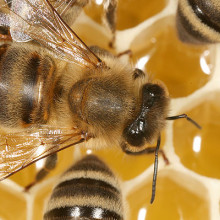
37:34 - Using Honey as the First Chemical Weapon
Using Honey as the First Chemical Weapon
with Fran Ashcroft, University of Oxford
We've heard how nature has informed our understanding of pain pathways and perception. But how exactly are these signals transmitted?
Also with us this week is Fran Ashcroft. She's Professor of Physiology at Oxford University and the author of several popular science books, including recently, The Spark of Life, which answers questions like why does an electric eel not shock 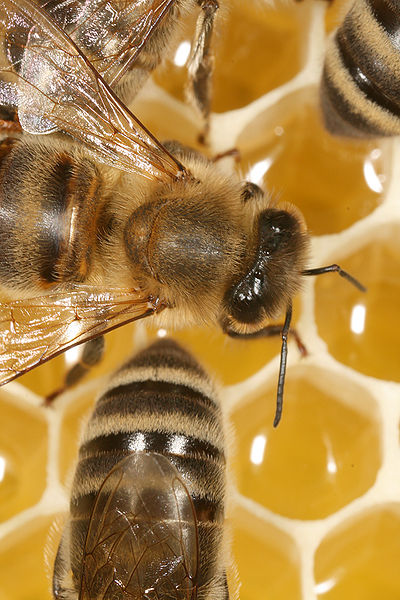 itself?
itself?
Hannah - So, Fran, you're the Professor of Physiology at Oxford University and you're also the author of several popular science books including most recently, The Spark of Life which answers questions such as, why does an electric eel not shock itself? So, ion channels, I believe that you've got one particular ion channel which is historically one of your favourites.
Fran - Well, my favourite ion channel is of course the one that I personally work on. But I think the one that you're referring to is one of my favourite stories. This is an ion channel which is involved in the sodium channel which is involved in the conduction of nerve impulses. As we've already heard, all sorts of chemicals can interact with ion channels. There is one which is known as grayanotoxin which is found in the pollen of a certain species of rhododendron which is found on the Black Sea. Its effects are best describe perhaps by Xenophon in 400 BC when he explains how his soldiers eat of the honey that was made from the pollen of these rhododendrons. And found themselves with lots of diarrhoea and purging, and vomiting, and having convulsions. He has this marvellous phrase that they all lay on the ground in a state of great dejection. Fortunately, they recovered and nothing really much happened for another 200 years until Pompey was invading that area. The Greeks remembered this story of Xenophon's and they collected the honey, and strewed it in the path of the oncoming troupes who at it, became incapacitated.
Hannah - So, the troops took a little break ate the honey that had been there as a honey trap and...
Fran - And were incapacitated and were then decapitated. So, this was perhaps one of the earliest forms of chemical warfare and I shouldn't say this, but at the same time, it's another example of the fact that one should not trust Greeks bearing gifts.
Hannah - And what was this toxin actually doing to the ion channels then?
Fran - What the toxin does is it holds the sodium channels open. We've heard already about toxins which act by blocking ion channel function. This one acts by enhancing the activity of this particular ion channel.
Hannah - And it had this wide ranging number of effects on the digestive system and then of the eventual decapitation of the soldiers.
Fran - There was another coda to this story really and that is, that these days, of course the rhododendrons are still there, the honey is still produced by the local bees. The honey's blended in with many other honeys. So, the toxin is diluted out. But in that local area, you can actually get the honey that is made specifically from this particular species of rhododendron. It has a local vogue as an aphrodisiac which is rather unfortunate and there are even stories today - you can read them, very recent papers in the scientific journals - of men who have taken some of these and ended up in a hospital rather acutely ill.
Hannah - That's an interesting story. So, you mentioned that you work on a similar type of ion channel now.
Fran - It's slightly different. The ion channel that I'm very interested in is one that's found in the cells of the pancreas. This channel is involved in the regulation of insulin secretion. So, as most people know insulin is the hormone that controls your blood sugar level and if you don't have enough, you get diabetes. I've been very interested in trying to understand what is the cause of diabetes. What we found was that when this ion channel is open, insulin is not released and when the ion channel is closed, insulin is released. I know that sounds counter intuitive, but the insulin is not going through the channel. The closing of the channel just triggers a whole series of events. What's been particularly exciting for me is that a colleague of mine recently found that mutations in this particular gene cause diabetes at birth. We've been able then to take that forward and show how this happens. What's been really extraordinary is that children with this disease were always treated by insulin injections. But when we recognised that they had a problem with their ion channels, we knew of a drug which shut the open channels. And so, we were able to transfer the patients from insulin injections onto drug therapy. And of course, that's transformed their lives. It's made their blood sugar control very much better and it's also, they prefer not having injections. You can imagine, it's difficult to inject a 3-month-old baby. I should just mention that this is a very rare disease. So, it's very unlikely too that most people who've got diabetes when they were young - it's only found in patients who have diabetes before the age of 6 months.
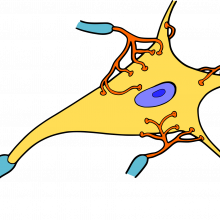
42:39 - Nerves Signals and Light
Nerves Signals and Light
with Karl Deisseroth, Stanford University
Karl Deisseroth is based at Stanford University in California and in 2005 he invented a new technique called optogenetics; this is a way of controlling nerve cells using light. He told Chris Smith how it works...
Karl - Well, optogenetics works by using light to open ion channels. We've heard a lot about ion channels and how they can be controlled by the electrodes that Hodgkin and Huxley used. Of course, those could only be put into a squid axon and if you want to study the mammalian brain where things are a thousand times smaller, you've got problems with putting enough electrodes in. We've also heard about chemicals that can affect ion channels. We can open and then close them. Those are great. Those can get all the way through the brain, but they don't have this millisecond precision that is the normal currency of information flow in the brain. So, what if you could have both? What if, you could high speed and allow access to many different neurons at once, even in let's say, the mammalian brain? So, what we do is, we found that there are some microorganisms that make just the perfect tool for this. They do it for their own reasons. Not to help us out, but it turns out to be the perfect thing. There are small algae, small kinds of bacteria as well that make light activated ion channels and they use this to sense what going on in their environment, to respond to it appropriately, to generate energy for a whole range of different functions.
Chris - So, these are marine microorganisms which just happen to make a chemical structure which is sensitive to light. They use it for one job, to regulate their behaviour that you're saying, you can steal that and use it for your purposes.
Karl - We did. We capitalised on the millions of years of evolution that went in to designing these beautiful proteins. We bring them into a mammalian neurons and we can turn mammalian neurons which normally don't care about light very much, turn them into very sensitive, precise light responding units.
Chris - So, you take the gene from the alga which would normally make that channel that the alga uses then you can put that gene into the nerve cell, making the nerve cell respond to light in the same way the algae would.
Karl - That's exactly right and it sounds a little farfetched and in fact, a lot of people thought that it would be very unlikely that genes from these algae or these ancient forms of bacteria would work well in mammalian cells, that they would get to the right place in the cell, that they would have the right supporting components that would help them function well. To some extent, they needed some help, we had to engineer the tools a bit to help them work well. In the end though, it works quite well now and we can flash on pulses of light of different colours. We can turn on and off different kinds of cells even while animals are freely behaving.
Chris - So, you put the gene from the alga into the nerve cell and it's in some way colour selected so you can use different colours to control different subsets of cells.
Karl - That's right. Some algae make proteins that respond to blue light, some archaebacteria make proteins that respond to amber light. In fact, there's a whole spectrum of these that are made by nature and that we can tune somewhat also with some protein engineering. We can put one kind of protein into one kind of cell, another kind of protein into another kind of cell, and even start to act like the conductor of the orchestra if you will, and have different elements, different instruments that play at different times or at the same time.
Chris - How do you put the genes into the brain cells that you want them to go into, in the animal that you want to study?
Karl - Well, this was the hardest thing after the initial proof of principle that these tools could work well in cells. The question became, how do you actually are going to make it useful? How are you going to target these into the cells of interest? This took a few years to sort out. It was helped by the fact that these are all-in-one proteins that it's just a single gene that's make a single protein that does all the jobs that gets the photons from light, and it delivers the ion flow. So, we only had to put one thing in and we use a range of genetic tricks. Actually, we can use little bits of DNA that are called promoters or enhancers and different cells that do different jobs will turn on or off these little bits of DNA that govern the expression or the production of proteins and cells. If we attach these little bits of DNA, the promoters or enhancers to the gene for the light responsive protein, and then we put that into all the cells in a region, it'll only get turned on in some, and that gives us a very powerful kind of specificity. There are other kinds too. For example, we can use the very remarkable shape and morphology of neurons. If we put the gene into one region of the brain, but we deliver light into another region of the brain that may be far away, we can selectively therefore stimulate the cells that live in one region, but send a connection to the other region where we're delivering the light. That turns out to be very powerful. We call that projection targeting and that, you don't actually need to know any genetics at all. You just need to know your anatomy.
Chris - How do you get the light that's going to do those jobs into the right bit of the nervous system in your animal?
Karl - Yes, that was another thing we had to sort out. In fact, a lot of the scepticism early on, people said, well, light doesn't penetrate very deeply into the brain and that's true. It will only go about a millimetre in before it's 99% scattered and absorbed. But we developed fibre optic methods for targeting very deep brain structures and so now, we can play in patterns of activity into very deep structures in the middle of the brain and the brain stem even while animals are behaving.
Chris - What can you do with this that we couldn't do before?
Karl - Well now we can play in precise patterns of activity into defined cells and I'll give you just one example. I'm interested in motivation and reward, what makes people want to do things, what makes them feel good about doing things. This is something that is impaired in depression and various kinds of psychiatric disease. And we're now playing in different patterns of activity into a kind of cell called the dopamine neuron and we're determining that some patterns of activity, but not others turn out to control feelings of reward or motivation. And that may help us understand these psychiatric diseases.

48:44 - Why does the sense of smell heighten during pregnancy?
Why does the sense of smell heighten during pregnancy?
So, is it true that sense of smell increases during pregnancy? We churn over the data with Professor Paul Breslin from the Monell Chemical Senses Centre in Philadelphia...
Paul - It's quite common for pregnant women to report that odours are stronger for them, that they're more sensitive to odours, that they're somewhat less tolerant of ambient room odours and that odours tend to be more unpleasant.
Laboratory studies have shown that pregnant women rate above-threshold odorants - those that are weak to moderately strong - as more intense than do non-pregnant women. There's little evidence, however, that pregnant women are more sensitive to odours in the absolute detection sense. That is, they're not able to detect the presence of odours at lower concentrations.
Hannah - So, it appears that the widely-reported claim that sense of smell heightens during pregnancy is not due to increased smell sensitivity, but actually, due to above-threshold smells appearing stronger and making them appear more disgusting. But why does this happen? Over to Tim Jacob, Professor of the Psychophysiology of Smell at Cardiff University.
Tim - This particularly happens in the first trimester of pregnancy and it's thought that there is some evolutionary advantage here in that it's necessary for the mother to be very careful what she ingests, not to ingest toxins and other poisons, both for her own health and for that of her foetus.
Hannah - So, what could be controlling this sense of smell during pregnancy? Back to Paul.
Paul - We have found that female hormones can greatly increase sensitivity to odours in women who are attending to them compared to females who are too young to cycle or compared to post-menopausal women. So, it appears that female hormones can influence the function of the olfactory system.
Hannah - Thanks, Paul and also do Adam who got in touch with the question. And finally, thanks to Tim who also points out that there are cases of expectant mothers with a decreased sense of smell. So, it's not a hard and fast rule for all...










Comments
Add a comment